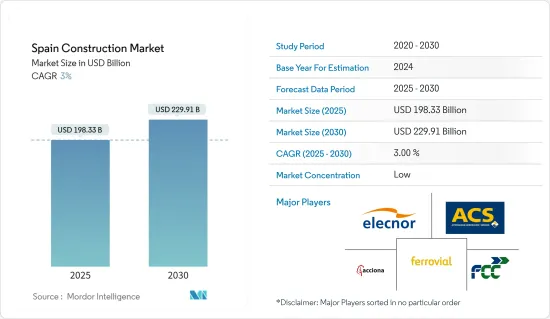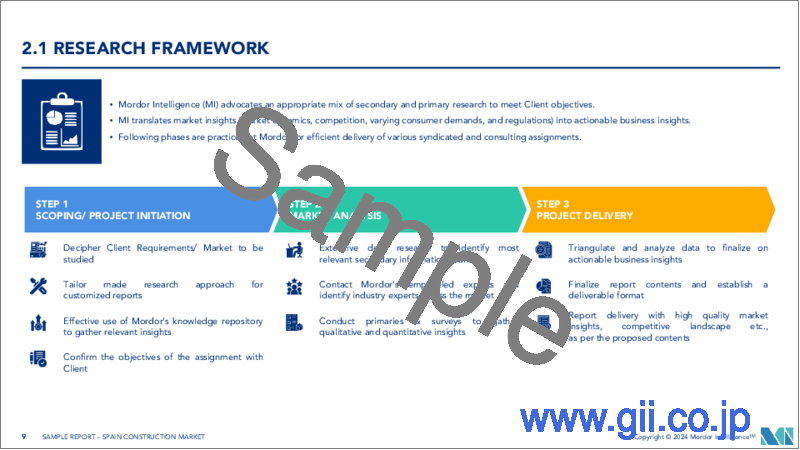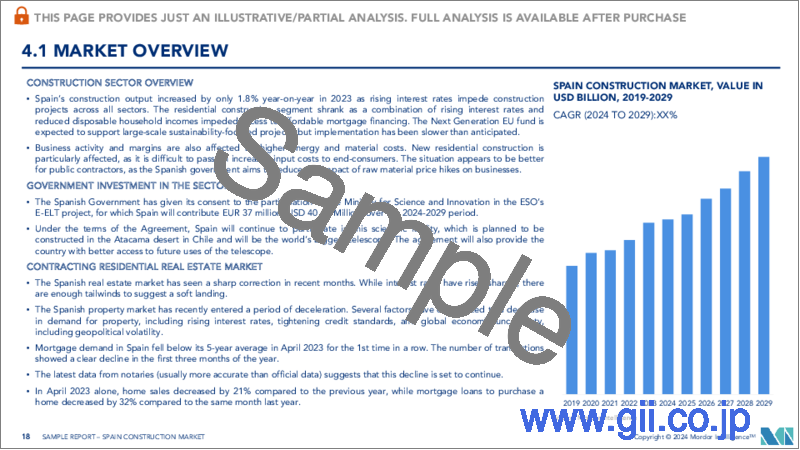|
|
市場調査レポート
商品コード
1644290
スペインの建設:市場シェア分析、産業動向と統計、成長予測(2025年~2030年)Spain Construction - Market Share Analysis, Industry Trends & Statistics, Growth Forecasts (2025 - 2030) |
||||||
カスタマイズ可能
適宜更新あり
|
|||||||
| スペインの建設:市場シェア分析、産業動向と統計、成長予測(2025年~2030年) |
|
出版日: 2025年01月05日
発行: Mordor Intelligence
ページ情報: 英文 150 Pages
納期: 2~3営業日
|
全表示
- 概要
- 目次
スペインの建設市場規模は2025年に1,983億3,000万米ドルと推定され、2030年には2,299億1,000万米ドルに達すると予測され、予測期間(2025~2030年)のCAGRは3%です。

主要ハイライト
- 2024年、スペインの建設産業は、エネルギー、交通、住宅、産業インフラなどの重要セクターへの戦略的投資により、安定した成長を遂げます。このセクターは、EUのNGEU(NextGenerationEU)復興基金からの拠出を中心に、多額の公的資金の恩恵を受けています。この資金は、特に再生可能エネルギーやスペインの全国交通網の重要なアップグレードなど、大規模なインフラプロジェクトに向けられています。これらの投資は、このセクターの成長を促進するだけでなく、スペインの広範な経済回復と長期的な持続可能性目標に大きく貢献すると期待されています。
- 最近の動向では、資本の流入とインフラ開発への旺盛な需要が相まって、この産業の継続的な成長に拍車がかかりそうだと強調されています。主に再生可能エネルギー、住宅プロジェクト、交通インフラへの取り組みに牽引され、このセクターは、当面はより緩やかなペースではあるもの、拡大基調にあります。
- 例えば、VENERGY+は、エクストレマドゥーラ州カセレスのナバルモラル・デ・ラ・マタにリチウム電池製造工場を建設中です。工事は2024年第3四半期に着工し、2028年第4四半期に完成する予定です。この工場は、電気自動車向けのゼロエミッション・バッテリーを生産することを目的としています。2024年10月にWorld Construction Networkが取り上げたように、この工場は完全に再生可能エネルギーで運営されます。
- いくつかのマクロ経済的課題に直面しているもの、スペインの建設産業は、持続的な公共投資と外国投資を活用する態勢を整えています。インフラプロジェクトが進む中、同産業はサステイナブルインフラと従来型のインフラの両方への投資によって、今後数年間は安定した成長を遂げると考えられます。
スペインの建設市場の動向
グリーンでサステイナブル建設
政府の施策と市場の需要により、エネルギー効率の高い建物、環境に配慮したインフラ、サステイナブル建設手法へのシフトが顕著になっています。この動向に合わせて、スペイン政府は2026年までに50万戸の住宅改修に多額の投資を行い、エネルギー効率を優先しています。さらに、BREEAMやLEEDなど、住宅、商業、工業の各セグメントにまたがるグリーンビルディング認証への需要が高まっています。
スペイン政府は、2026年までに50万戸の住宅を改修することを決定しており、エネルギー効率への重点的な取り組みを強調しています。この試みは、グリーンの建設活動の著しい急増を裏付けています。高騰するコストや労働力不足といったハードルがあるにもかかわらず、スペイン政府は建設部門を若返らせ、拡大するための重要なイニシアティブを展開しています。
The Green Building Insiderの報告書によると、スペインは様々な都市で166のサステイナブル認証ビルを誇っています。トップはマドリードで、僅差でバルセロナとビスカヤ州が続きます。その内訳は、98棟がオフィス用、24棟が商業用、11棟が工業用となっています。特筆すべきは、スペインにおける持続可能性の至宝は、アリカンテにある欧州連合知的財産庁(EQUIPO)です。さらに、マドリードのトッレ・リオハにあるAA81ビルは、名誉あるLEEDプラチナ認証を堂々と取得しています。
ロイター通信は7月29日、マドリードから次のように報じました。スペイン政府は約300の再生可能エネルギープロジェクトを認可し、その合計容量は28ギガワットを超えます。この動きは、野心的なグリーンエネルギー目標の達成を目指すスペインにとって極めて重要です。
結論として、エネルギー効率とサステイナブル建設に対するスペインの積極的なアプローチは、その大規模な投資と施策イニシアチブを通じて明らかです。こうした取り組みは、グリーンエネルギー目標の達成を目指すだけでなく、スペインをサステイナブル開発のリーダーとして位置づけています。
住宅部門が牽引するスペインの建設市場
スペインの建設市場は、主に住宅部門が牽引する力強い上昇を目の当たりにしています。産業団体のデータによると、2024年の住宅建設承認件数は急増し、12万戸を目指すといわれています。この勢いは2025年まで続き、新設住宅着工戸数は約15%増加すると予測されています。住宅販売は回復力を示しており、2024年の最初の5ヵ月で6.1%の伸びを記録しました。同時に、新規建築許可件数は小幅ながら2024年1月から5月の間に前年同期比14.8%増を記録しました。このような市場の活況は、新興経済諸国と相まって金利が低下し、住宅購入者にも開発業者にも好都合な雰囲気が醸成されたことが主因と考えられます。
しかし、市場は住宅需給の不均衡が続き、価格の高騰を招いています。産業の報告書によると、2024年第1四半期の住宅価格は前年同期比4.3%上昇し、急増する住宅需要に対応するための課題が浮き彫りになっています。このシナリオは、特に人口密度の高まりを目の当たりにしている都市部において、住宅生産が急増する需要に対応するのに苦労している市場の姿を描き出しています。その結果、開発業者は、急成長する機会をとらえようと、新たな住宅プロジェクトに舵を切っています。
この住宅の勢いをさらに加速させているのが、スペイン政府の住宅に対する積極的な姿勢です。包括的なイニシアチブの一環として、政府は4万3,000戸の手頃な賃貸住宅を建設する計画を発表し、60億ユーロ(63億2,000万米ドル)という多額の資金を投入しました。2024年7月にDawn Digestが報じたこのイニシアチブは、住宅不足の解消を目指すだけでなく、住宅建設におけるエネルギー効率と持続可能性も重視しています。このような試みは、建設活動を活性化し、同部門の雇用創出を強化する態勢を整えています。
結論として、住宅部門は2024年以降もスペインの建設市場を牽引する極めて重要な存在であり続けると考えられます。政府の支援策、景気回復、住宅需要の増加により、同部門は持続的成長を遂げる好位置にあります。しかし、市場の長期的な安定と値ごろ感を確保するには、需給ギャップの解消が不可欠です。
スペインの建設産業概要
市場はセグメント化されており、ACS Actividades de Construccion y Servicios S.A.、Acciona S.A.、FCC Construccion S.A.(FCC Group)、Ferrovial S.A.、Sacyr S.A.、Ferrovial S.A.、Dragados S.A.(ACS Groupの一部)、Elecnor S.A.、Obrascon Huarte Lain S.A.(OHLA Group)、Vinci S.A.(スペイン市場で活躍するフランスの多国籍企業)、Isolux Corsanなどです。サービスプロバイダー間の競合は、満たさなければならない厳しい規制要件によってさらに激化しています。開発企業は、製品ラインの開発や地域拡大のためにM&A取引に参加しています。
本レポートでは、スペインの建設市場で事業を展開する主要企業を取り上げています。建設投資の増加、同国における今後の大規模プロジェクト、その他の関連要因により、予測期間中に市場は成長すると予想されます。
その他の特典
- エクセル形式の市場予測(ME)シート
- アナリストによる3ヶ月間のサポート
目次
第1章 イントロダクション
- 調査の前提条件
- 調査範囲
第2章 調査手法
- 分析手法
- 調査フェーズ
第3章 エグゼクティブサマリー
第4章 市場分析
- 現在の経済と建設市場のシナリオ
- 建設セグメントにおける技術革新
- 建設・建築資材に関連するコストに関する洞察
- 政府の規制と取り組みが産業に与える影響
- スペインのプレハブ建築市場の注目点
- 不動産市場概要と主要不動産参入企業
- 建設関連サービス(設計・エンジニアリング、フィットアウトサービス、施設管理など)に関する洞察
- 建設資材の主要流通業者/貿易業者に関する洞察
- バリューチェーン/サプライチェーン分析
- 地政学とパンデミックが市場に与える影響
第5章 市場力学
- 促進要因
- 住宅需要の増加
- 交通インフラ需要の増加
- 抑制要因
- 人件費の高騰
- 材料費の高騰
- 機会
- 最新技術の採用
- 環境に優しくサステイナブル建設
- 産業の魅力-ポーターのファイブフォース分析
- 供給企業の交渉力
- 消費者/買い手の交渉力
- 新規参入業者の脅威
- 代替品の脅威
- 競争企業間の敵対関係の強さ
第6章 市場セグメンテーション
- セクター別
- 住宅
- 商用
- 産業
- インフラ(輸送)
- エネルギーと公益事業
第7章 競合情勢
- 企業プロファイル
- ACCIONA CONSTRUCCION SA
- ELECNOR SA
- FCC CONSTRUCTION SA
- DRAGADOS SOCIEDAD ANONIMA
- COBRA INSTALACIONES Y SERVICIOS SA
- FERROVIAL AGROMAN SA
- TSK ELECTRONICA Y ELECTRICIDAD SA
- ACS, ACTIVIDADES DE CONSTRUCCION Y SERVICIOS, SA
- ADMINISTRADOR DE INFRAESTRUCTURAS FERROVIARIAS
- OBRASCON HUARTE LAIN SA
- ADIF ALTA VELOCIDAD
- SACYR CONSTRUCCION SAU*
第8章 市場機会と今後の動向
第9章 付録
- マクロ経済指標(部門別GDP内訳、建設業の経済貢献など)
- 建設資材の主要生産、消費、輸出、輸入統計
The Spain Construction Market size is estimated at USD 198.33 billion in 2025, and is expected to reach USD 229.91 billion by 2030, at a CAGR of 3% during the forecast period (2025-2030).

Key Highlights
- In 2024, Spain's construction industry is set to experience steady growth, driven by strategic investments in vital sectors such as energy, transportation, housing, and industrial infrastructure. The sector is benefiting from significant public funding, with a notable emphasis on contributions from the EU's NextGenerationEU (NGEU) Recovery Fund. This funding is being directed towards major infrastructure projects, especially in renewable energy and crucial upgrades to Spain's national transportation network. These investments are expected to not only propel the sector's growth but also significantly contribute to Spain's broader economic recovery and long-term sustainability goals.
- Recent reports highlight that an influx of capital, combined with strong demand for infrastructure development, is likely to fuel continued growth in the industry. Driven primarily by initiatives in renewable energy, housing projects, and transportation infrastructure, the sector is on track for expansion, albeit at a more tempered rate in the immediate future.
- For instance, VENERGY+ is building a lithium battery manufacturing plant in Navalmoral de la Mata, Caceres, Extremadura. Construction kicked off in Q3 2024, with an anticipated completion in Q4 2028. The facility aims to produce zero-emission batteries tailored for electric vehicles. Notably, the factory will operate entirely on renewable energy, as highlighted by World Construction Network in October 2024.
- Despite facing several macroeconomic challenges, Spain's construction industry stands poised to capitalize on sustained public and foreign investments. With infrastructure projects advancing, the sector is set for steady growth in the coming years, fueled by investments in both sustainable and traditional infrastructure.
Spain Construction Market Trends
Green and Sustainable Construction
Government policies and market demand are steering a pronounced shift towards energy-efficient buildings, green infrastructure, and sustainable construction practices. In alignment with this trend, the Spanish government is channeling substantial investments into the renovation of 500,000 homes by 2026, prioritizing energy efficiency. Furthermore, there's an escalating demand for green building certifications, such as BREEAM and LEED, spanning residential, commercial, and industrial sectors.
Spain's government is set to revamp 500,000 homes by 2026, underscoring a pronounced focus on energy efficiency. This endeavor underscores a marked surge in green construction activities. In spite of hurdles like escalating costs and labor shortages, the Spanish government has rolled out pivotal initiatives to rejuvenate and expand the construction sector.
According to a report by The Green Building Insider, Spain boasts 166 certified sustainable buildings across various cities. Leading the pack is Madrid, followed closely by Barcelona and the province of Vizcaya. Breaking it down, 98 of these certified buildings serve as offices, 24 are designated for commercial use, and 11 cater to industrial purposes. Notably, the crown jewel of sustainability in Spain is the European Union Intellectual Property Office (EQUIPO) situated in Alicante. Additionally, the AA81 building in Torre Rioja, Madrid, stands out as another prime example, proudly holding the prestigious LEED Platinum certification.
On July 29, Reuters reported from Madrid: The Spanish government has greenlit nearly 300 renewable energy projects, boasting a combined capacity exceeding 28 gigawatts. This move is pivotal for Spain as it strives to achieve its ambitious green energy targets.
In conclusion, Spain's proactive approach towards energy efficiency and sustainable construction is evident through its substantial investments and policy initiatives. These efforts not only aim to meet green energy targets but also position Spain as a leader in sustainable development
Spain's Construction Market Fueled by Residential Sector
Spain's construction market is witnessing a robust upswing, predominantly driven by the residential sector. Data from industry associations indicate that residential construction approvals are poised to surge in 2024, targeting 120,000 units. This momentum is projected to carry into 2025, with new housing starts anticipated to rise by approximately 15%. Housing sales have shown resilience, marking a 6.1% growth in the initial five months of 2024. Concurrently, new building permits, though at a modest level, recorded a year-on-year uptick of 14.8% between January and May 2024. This buoyancy in the market can be largely attributed to declining interest rates coupled with a rejuvenating economy, fostering a conducive atmosphere for both homebuyers and developers.
However, the market grapples with a persistent imbalance between housing supply and demand, leading to escalating prices. Industry reports highlight a 4.3% year-on-year surge in residential property prices in Q1 2024, underscoring the challenges in catering to the burgeoning demand for housing. This scenario paints a picture of a market where housing production struggles to match the escalating demand, especially in urban locales witnessing heightened population density. Consequently, developers are pivoting towards new residential projects, eager to seize the burgeoning opportunity.
Driving this residential momentum further is the Spanish government's proactive stance on housing. As part of a comprehensive initiative, the government has unveiled plans to construct 43,000 affordable rental homes, channeling a substantial EUR 6 billion (USD 6.32 billion) in funding. This initiative, reported by Dawn Digest in July 2024, not only seeks to alleviate housing shortages but also emphasizes energy efficiency and sustainability in residential constructions. Such endeavors are poised to invigorate construction activities and bolster job creation in the sector.
In conclusion, the residential sector is set to remain a pivotal force in driving Spain's construction market in 2024 and beyond. With supportive government initiatives, a recovering economy, and increasing demand for housing, the sector is well-positioned for sustained growth. However, addressing the supply-demand gap will be critical to ensuring long-term stability and affordability in the market.
Spain Construction Industry Overview
The market is fragmented with a large number of players, including ACS Actividades de Construccion y Servicios S.A., Acciona S.A., FCC Construccion S.A. (FCC Group), Ferrovial S.A., Sacyr S.A., Dragados S.A. (Part of the ACS Group), Elecnor S.A., Obrascon Huarte Lain S.A. (OHLA Group), Vinci S.A. (French multinational active in the Spanish market), Isolux Corsan, etc. The competition amongst service providers is further heightened by the strict regulatory requirements that must be met. Businesses participate in M&A transactions to develop their product lines and expand regionally.
The report covers the major players operating in the Spanish construction market. The market is expected to grow during the forecast period due to the increase in construction investments, upcoming major projects in the country, and other related factors.
Additional Benefits:
- The market estimate (ME) sheet in Excel format
- 3 months of analyst support
TABLE OF CONTENTS
1 INTRODUCTION
- 1.1 Study Assumptions
- 1.2 Scope of the Study
2 RESEARCH METHODOLOGY
- 2.1 Analysis Methodology
- 2.2 Research Phases
3 EXECUTIVE SUMMARY
4 MARKET INSIGHTS
- 4.1 Current Economic and Construction Market Scenario
- 4.2 Technological Innovations in the Construction Sector
- 4.3 Insights on Costs Related to Construction and Building Materials
- 4.4 Impact of Government Regulations and Initiatives on the Industry
- 4.5 Spotlight on Prefabricated Buildings Market in Spain
- 4.6 Brief on Real Estate Market and Key Real Estate Players
- 4.7 Insights on Services Allied to Construction (Design and Engineering, Fit-out Services, Facility Management, etc.)
- 4.8 Insights on Key Distributors/Traders of Construction Materials
- 4.9 Value Chain/Supply Chain Analysis
- 4.10 Impact of Geopolitics and Pandemics on the Market
5 MARKET DYNAMICS
- 5.1 Drivers
- 5.1.1 Increasing demand for Housing
- 5.1.2 Increasing demand for transportation infrastructure
- 5.2 Restraints
- 5.2.1 High Cost of Labour
- 5.2.2 Rising material costs
- 5.3 Opportunitites
- 5.3.1 Adoption of recent technologies
- 5.3.2 Eco-friendly and sustainable construction
- 5.4 Industry Attractiveness - Porter's Five Forces Analysis
- 5.4.1 Bargaining Power of Suppliers
- 5.4.2 Bargaining Power of Consumers/Buyers
- 5.4.3 Threat of New Entrants
- 5.4.4 Threat of Substitute Products
- 5.4.5 Intensity of Competitive Rivalry
6 MARKET SEGMENTATION
- 6.1 By Sector
- 6.1.1 Residential
- 6.1.2 Commercial
- 6.1.3 Industrial
- 6.1.4 Infrastructure (Transportation)
- 6.1.5 Energy and Utilities
7 COMPETITIVE LANDSCAPE
- 7.1 Overview (Market Concentration and Major Players)
- 7.2 Company Profiles
- 7.2.1 ACCIONA CONSTRUCCION SA
- 7.2.2 ELECNOR SA
- 7.2.3 FCC CONSTRUCTION SA
- 7.2.4 DRAGADOS SOCIEDAD ANONIMA
- 7.2.5 COBRA INSTALACIONES Y SERVICIOS SA
- 7.2.6 FERROVIAL AGROMAN SA
- 7.2.7 TSK ELECTRONICA Y ELECTRICIDAD SA
- 7.2.8 ACS, ACTIVIDADES DE CONSTRUCCION Y SERVICIOS, SA
- 7.2.9 ADMINISTRADOR DE INFRAESTRUCTURAS FERROVIARIAS
- 7.2.10 OBRASCON HUARTE LAIN SA
- 7.2.11 ADIF ALTA VELOCIDAD
- 7.2.12 SACYR CONSTRUCCION SAU*
8 MARKET OPPORTUNITIES AND FUTURE TRENDS
9 APPENDIX
- 9.1 Macroeconomic Indicators (GDP Breakdown by Sector, Contribution of Construction to Economy, etc.)
- 9.2 Key Production, Consumption, Exports & Import Statistics of Construction Materials





